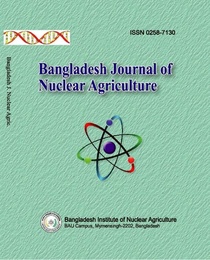FACTORS CONTRIBUTING TO ADOPTION OF MODERN SESAME PRODUCTION TECHNOLOGIES IN SOME SELECTED AREAS
Abstract
The study was conducted to assess the extent of adoption and also to determine the contribution of the selected factors to the adoption of modern sesame production technologies by the farmers of five villages of five districts (Kushtia, Chuadanga, Faridpur, Jashore and Narail). Data were obtained from 100 randomly selected farmers in five selected villages of five districts using the interview schedule. Data were collected from the sample during 15 September to 25 October, 2014. Half (51 percent) of the farmers had low adoption while 37 percent had medium and 12 percent had high adoption of modern sesame production technologies. Six factors out of 16 contributed significantly to the adoption of modern sesame production technologies by the farmers. The contributing factors were extension media contact, profitability of technology, cropping intensity, suitability of technology, credibility of extension agents andcosmopoliteness and their contributions were 40.7%, 15.2%, 12.3%, 8.9%, 1.6% and 1.8%, respectively. These six variables explained 80.5 percent of total variation in adoption of technological package of practices in relation to the adoption of modern sesame production technologies.
References
BBS. 2016. Statistical Year Book of Bangladesh. Bangladesh Bureau of Statistics, Statistics Division, Ministry of Planning, Government of People’s Republic of Bangladesh.
Chattapadhyay, S.N. 1963. A Study of Some Physchological Correlates of Adoption of Information in Farming. Ph.D. Thesis. Jadavpur University, Calcutta.
Chowdhury, M.S.A. 1997. Adoption of Selected BINA Technologies by the Farmers of Boyra Union in Mymensingh District. M.S. (Ag.Ex.Ed.) Thesis, Department of Agricultural Extension Education, Bangladesh Agricultural University, Mymensingh.
Draper, N.R. and SmithH. 1981. Applied Regression Analysis. New York: John Wiley and Sons Inc.
Hasan, A.F.M. F., Begum, S.,Furumoto, T.and Fukui, H. 2000. A New Chlorinated Red Napthoquinone from roots of Sesamumindicum. Biosci.Biotechnol.Biochem., 64: 873-874.
Hasan, A.F.M. F., Furumoto, T.,Begum,S.and Fukui,H.. 2001. Hydroxysesamone and 2, 3-epoxysesamone from roots of Sesamumindicum. Phytochemistry. 58: 1225-1228.
Hussen, M.A. 2001. Farmers’ knowledge and adoption of modern sugarcane cultivation practices. M.S. (Ag.Ext,Ed) Thesis, Department of Agricultural Extension Education, Bangladesh Agricultural University, Mymensingh.
Pathak, S. and Majumdar, A.K. 1985. A Study of Psychological Factors Associated with Attitude, Knowledge and adoption of Suphala (unpublished master’s thesis). Department of Agricultural Extension, Bidhan Chandra KrishiViswavidyalay, West Bengal, India.
Ray, G. L. and Mondal, S. 2004. Research Methods in Social Sciences and Extensive Education (2nd ed.), New Delhi: Kalyani Publications.
Ray, G. L. 1998. Extension Communication and Management, Third Edition. Calcutta: Naya Prokash.
-
Download



